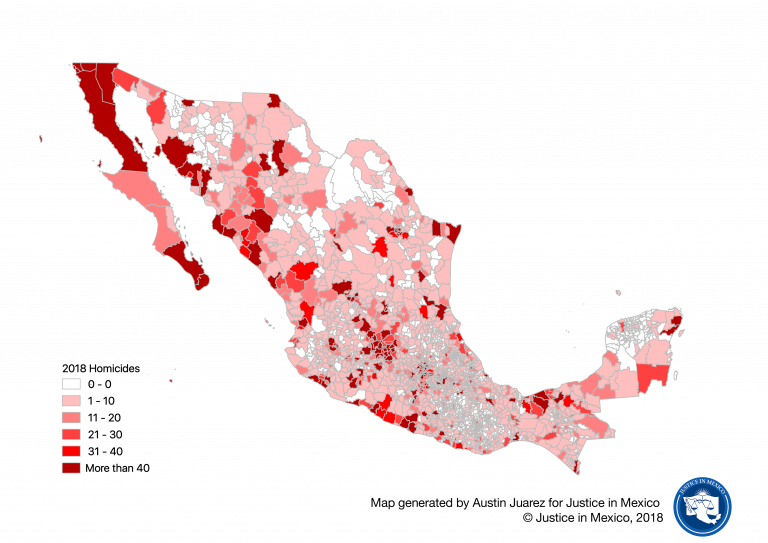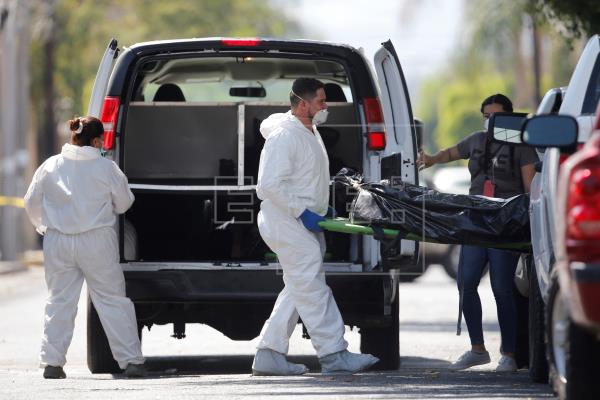06/26/19 (written by kheinle) — The first six months of President Andrés Manuel López Obrador’s sexenio (2018-2024) have proven to be the most violent such period for a president in Mexico’s recent history. Mexico’s ongoing struggles to combat crime and violence were highlighted of late with the release of data on the increasing homicide rates and clandestine graves throughout Mexico.
Intentional Homicide Rate Continues to Rise

According to Mexico’s Secretary General of National Public Security (Secretariado Ejecutivo del Sistema Nacional de Seguridad Pública, SESNSP), 17,498 people were murdered between December 2018 and May 2019; an average of almost 3,000 per month. Despite a slight drop in the number of intentional homicides reported in April (2,724 homicides) compared to previous months, May saw an increase to the highest tally yet for 2019 with 2,903 killings, or the equivalent of 96 per day. February, however, continues to have the highest number of homicides per day on average in 2019 (102 homicides/day) thanks to similar numbers reported (2,877 homicides) over fewer days in the month (28 days).
The mid-year data also revealed that just over half of Mexico’s 32 state and federal entities saw increases in the number of homicides registered since the start of the López Obrador administration. According to SESNSP’s data, when compared to the same period of time the year before (December 2017 – May 2018), the most significant or “worrisome” increase in homicide rates occurred in Nuevo León. As reported by Animal Político, Nuevo León’s homicide rate increased from 5.3 homicides per 100,000 individuals to 9.2 homicides per 100,000 individuals. The 72% increase far surpassed the rises in Tabasco (50.7%), Mexico City (43.2%), Sonora (43.1%), and Morelos (42.5%). Meanwhile the states with the largest decreases in homicide rates during that time period were Baja California Sur (78.3% reduction), Nayarit (69%), and Guerrero (30.8%).

The media’s role in disseminating information on homicides is also of note. A recent report by El Universal with support from Google News Initiative found that the Mexican media in ten different states have decreased the amount of coverage given to homicides reported in 2019 compared to previous years. In particular, Baja California Sur, Chihuahua, and Nayarit have published the least information proportional to number of homicides committed in 2019. The states of Aguascalientes, Colima, Guerrero, Guanajuato, Michoacán, Puebla, Quinata Roo, Tamulipas, and Zacatecas round out the list of ten. The authors looked at official homicide data spanning from 2005 to 2019 vis-à-vis the press’ reporting on such killings.
Justice in Mexico’s annual report released in April 2019, “Organized Crime and Violence in Mexico: Data and Analysis Through 2018,” also took an in depth look at SNSP’s 2018 data. The authors found, for example, that although Baja California had the highest number of intentional homicide cases in 2018 (2,805), Guanajuato had the largest annual increase in total homicides, nearly doubling its recorded number from 2017. To read more about Mexico’s crime and violence at the federal, state, and local levels in 2018, check out Justice in Mexico’s full report here.
Clandestine Graves and Desaparecidos
In addition to Mexico’s record-breaking levels of homicide, the nation continues to grapple with the existence of clandestine graves and associated disappearances (desaparecidos).

In mid-June, researchers with Mexico City’s Universidad Iberoamericana confirmed the existence of 1,606 clandestine graves throughout Mexico. According to their report, “Violence and terror: findings on clandestine graves in Mexico 2006-2017” (“Violencia y terror: hallazgos sobre fosas clandestinas en México 2006-2017”), the states in which the most sites were located were Guerrero, Sinaloa, Tamaulipas, Veracruz, and Zacatecas. The graves documented are from 2006 and 2017, a period of time that spans almost two presidents’ full sexenios (Felipe Calderón, 2006-2012; Enrique Peña Nieto, 2012-2018). According to the Associated Press, the graves found “may just scratch the surface of the true numbers behind what the [Universidad Iberoamericana] study called a ‘building phenomenon.’”
The reported graves contained nearly 2,500 bodies, of which the predominant majority are tied to the ongoing battles between drug-trafficking organizations (DTO) and organized crime groups (OCG). The researchers also clarified that their data was not comprehensive because eight of Mexico’s 32 states and federal entities did not submit data or documentation to their research project, claiming that no graves had been found within their entities during the specified timeframe.
Contextualizing the data, the report out of Universidad Iberoamericana emphasized the role that Mexico’s high levels of impunity have in perpetuating the existence of secret graves. “It is reflective of the level of social decay and dehumanization that the country has reached,” the researchers wrote. Jan Jarab, representative of the Office of the United Nations High Commissioner for Human Rights (OHCHR) in Mexico, also weighed in on the findings. “This horror map of clandestine graves can only be combatted with strategies addressing impunity,” he said.
Such disappearances like the victims’ remains found in the graves have long been a critical issue in Mexico. According to the government’s national search commission, there are more than 40,000 persons estimated missing in Mexico.
Impunity vis-à-vis the NSJP

Mexico’s systemic challenges with crime, violence, impunity, and the ways in which they manifest themselves in society (i.e., clandestine graves) were recently at the center of criticism leveled by human rights activist Alejandro Martí toward the government. According to Martí, who is the head of the organization México SOS, Mexico’s New Criminal Justice System (Nuevo Sistema de Justicia Penal, NSJP) carries some of the responsibility in perpetuating impunity. “The fundamental problem of the [NSJP] is the corruption,” he said. “And corruption produces this terrible impunity, which I have said for years. Impunity is a result of all the wrongs of Mexico.”
Martí also called out elected officials – particularly governors – and the police for the pervasiveness of corruption within their systems. He reminded the media with which he spoke that “half of the group of kidnappers who killed my son were police,” referencing his son’s murder in 2008 that led him to become an activist. Martí leveled his criticisms during a press conference promoting Mexico’s 8th National Forum on Security and Justice (“8° Foro Nacional de Seguridad y Justicia”) held June 7-8.
Whether the New Criminal Justice System does indeed bear some of the responsibility, as Martí alleges, it is clear nonetheless that the López Obrador Administration faces systemic challenges when addressing Mexico’s notorious levels of crime and violence. Homicide rates, clandestine graves, disappearances, and impunity are but a few.
Sources:
Román, Esteban. “En 10 estados guardan silencio sobre homicidios.” El Universal. June 13, 2019.
“Today in Latin America.” Latin America News Dispatch. June 21, 2019.




